Ernemann
| Camera industry in Dresden |
| Balda | Certo | Eho-Altissa | Eichapfel | Ernemann | Feinmess | Heyde | Hamaphot | Huth | Hüttig | ICA | Ihagee | Kochmann | Kerman | KW | Eugen Loeber | Ludwig | Mentor | Merkel | Meyer | Mimosa | Pentacon | Richter | Sommer | Stübiger | Unger & Hoffmann | Werner | Wünsche | Zeiss Ikon | Zeh |
| Camera distributors in Dresden |
| Stöckig |
| Camera industry in Freital |
| Beier | Pouva | Stein & Binnewerg | Thowe | Welta |
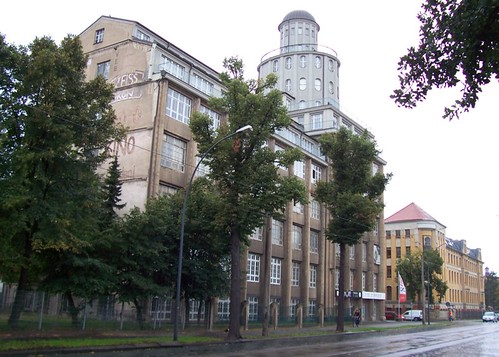
|
| The Ernemann factory buildings with the famous Ernemann Tower image by Uwe Kulick (Image rights) |
History
Heinrich Ernemann (1850–1928) began his entrepreneurship with a shop for linen goods, trimmings and stockings in Dresden. In 1889 he and his partner Mr. Matthias founded Dresdner Photographische Apparate-Fabrik Ernemann & Matthias. Since 1890 they powered their factory with steam engines, and one year later, in 1891, Matthias left the company.
Ernemann was self-educated about photography and talented for getting into that business. The first products of his company were wooden cameras for professional photographers. Until 1896 the company's own production was largely limited to the wooden parts; other parts had to be bought from suppliers.
Ernemann wanted to gain full control on camera production, therefore he added four new departments for camera parts production. The booming camera industry in Dresden led to a period of overproduction, but Heinrich Ernemann knew how to get through the crisis: he transformed his factory to a stock market company, the Heinrich Ernemann, Aktiengesellschaft für Cameraproduktion in Dresden, founded in 1899.
The new corporation produced cameras and movie projectors in Dresden and Görlitz. It took over the camera maker Ernst Herbst & Firl and continued its Globus camera series. From 1901 to 1907 it was exclusive maker of Stöckig's Union cameras. Later it used that brand itself.
In 1903 Ernemann began to produce small cine cameras for amateurs. In 1904, Heinrich called his son, Alexander Ernemann, back from the U.S. where he had gone five years earlier to get international experience, to become technical director in the company; with him the cinematographic activities were driven further. The first cinema projector didn't work well, but that failure resulted in the construction of the steel projector "Imperator" in 1909.
Alexander Ernemann also introduced more modern American ways of production and reward. This led to a strike in 1905 but put Ernemann into a better position when the photography industry suffered overproduction in 1908, forcing the company's competition to merge into ICA in 1909.
| Zeiss Ikon and related companies |
| Pre-Merger phase I (before 1909) |
| Hüttig | Wünsche | Krügener | Carl Zeiss Palmos | Nettel | Drexler & Nagel | Herbst & Firl |
| Pre-merger phase II (1909-1926) |
| Carl Zeiss | Ernemann | ICA | Goerz | Zulauf | Contessa-Nettel |
| Zeiss Ikon (1926 and after) |
| Zeiss Ikon | Pentacon |
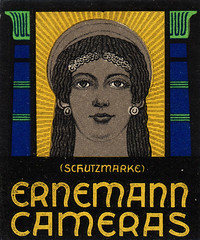
|
| company logo "light godess" image by Abdishev (Image rights) |
In 1907 Ernemann introduced its first SLR camera, and one year later, in 1908, started making its own lenses. Until then it had purchased lenses from Carl Zeiss and Goerz. Before the first world war, Ernemann employed Johan Steenbergen, who later founded Ihagee, also in Dresden.
During the war Ernemann partially switched to production of military products like its machine-gun camera and found many new customers for its "civil" vest pocket cameras among the soldiers. In 1920 Ernemann formed a company for its movie projectors together with the steel producer Krupp, Ernemann-Krupp Kinoapparate. The successor of this projector company still exists today (see links, below).
In 1923 the camera division moved to its new factory building in Dresden-Striesen. The building's central tower, designed by Emil Högg und Richard Müller, has stood in Dresden-Striesen since 1923,[1] It is still known today as the Ernemann Tower. This tower became the symbol of VEB Pentacon and has also been called the Pentacon tower.
The post-WWI times of the great German inflation until 1923 were good for Ernemann since inflation allowed low export prices for its products. In 1924 the company had to rationalize production, in spite of which Ludwig Bertele developed the "Ernostar 1:2" asymmetric lens with six elements for Ernemann. For this fast lens the company introduced the Er-Nox camera for 6x4.5 exposures in 1924. In 1925 a 6x9 format version followed, and the cameras were renamed Ermanox. The Ernostar lens could be improved. It was an unusually fast and large f/1.8 85mm lens, allowing photography in dimly-lit theaters and the like, using only available light.Finally a reflex version of the Ermanox was released in 1926. Other famous cameras from Ernemann include the Bob folding series and the Heag line of cameras as well as several sophisticated folding cameras.
In 1926 Ernemann merged with ICA, also in Dresden, Goerz in Berlin and Contessa-Nettel in Stuttgart to become Zeiss Ikon. By this time Ernemann had acquired 213 patents.
Cameras

|
| image by marcokalmann (Image rights) |
Ernemann
- Alex
- Archimedes and Archimedes Stereoskop
- Berry
- Bob series 0-XV, including:
- Bob-Folding I - III (horizontal-folding cameras)
- Bobette I
- Bobette II
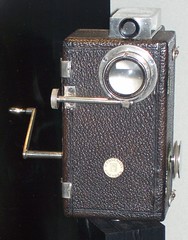
|
| Kino I (1903?) for 17.5mm film image by Uwe Kulick (Image rights) |
- Dove Stereoskop
- Edison
- Er-Nox
- Ermanox (rigid body)
- Ermanox (Klapp or strut-folding body)
- Ermanox Reflex
- Ernette
- Erni
- Erni Stereo
- Ernemann-Rundblick-Camera (360degrees panorama camera)
- Ernoflex
- Film K
- Europa
- Film and Film-Stereoskop
- Globus

|
| Miniatur-Klapp (1922) image by Abdishev (Image rights) |
- Globus Stereo
- Heag 0-XVI see list below
- Italia
- Kassetten-Film-Camera
- Kino I
- Klapp / Miniatur-Klapp
- Klapp Reflex
- Klapp Stereo
- Lea
- Liliput
- Liliput Stereo
- Mignon-Kamera
- Minor
- Miniatur-Ernoflex / Miniatur Klappreflex
- Moser-Stereoskop
- Multicolor
- Nansen, Nansen-Stereoskop
- Rolf I
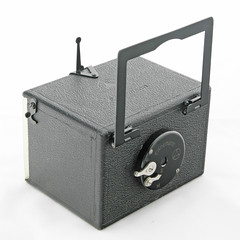
|
| Erni image by Abdishev (Image rights) |
- Rolf II
- Röntgen
- Schülerkamera ˶Alex˝
- Simplex
- Simplex Ernoflex
- Spiegelreflex-Camera
- Ernemann telescopic-folding plate camera
- Tropen-Klapp
- Unette
- Universal
- Velocam
- Velo-Klapp
- Zwei-Verschluss-Camera
Heag
- Heag 0, Heag 0A
- Heag 00
- Heag I, Heag I Stereoskop
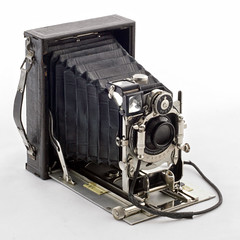
|
| Heag XVI (1907) image by Abdishev (Image rights) |
- Heag II, Heag IIa (amateur camera)
- Heag III
- Heag III Stereo
- Heag IV, Heag VI Stereoskop ** Heag V
- Heag VI
- Heag VII
- Heag VIII
- Heag IX, Heag IX Universal
- Heag X, Tropen Heag X
- Heag XI, Tropen Heag XI
- Heag XII
- Heag XIV
- Heag XV (vest pocket camera)
- Heag XVI
Notes
Literature
- Kirsten Vincenz, Wolfgang Hesse: Fotoindustrie und Bilderwelten - Die Heinrich Ernemann AG für Camerafabrikation in Dresden 1889-1926, Dresden 2008
Links
In English:

|
| 50 million Deutschmarks voucher, printed by Ernemann AG (German hyper-inflation 1923) image by Abdishev (Image rights) |
- Ernemann CineTec GmbH movie projectors (archived)
In German:
- Ernemann in German at Wikipedia
- Dresdner page about Ernemann-Werke
- Company history at dresdner-kameras.de
- Catalogue Ernemann Cameras sind die Besten; Anleitung; Liste No. 91 (undated, but describing the Bob III (1904-10) as new) at Ciné-Ressources
- Ernemann catalogue pages (slow-loading PDF) at Photographica World
In French:
- Ernemann page at Collection G. Even's site
- Ernemann Cameras at www.collection-appareils.fr
